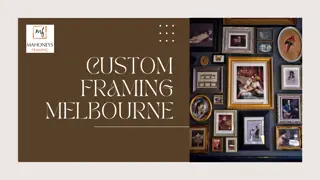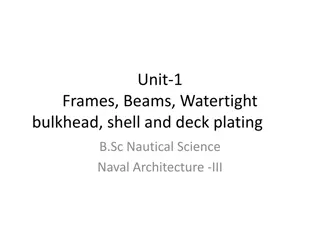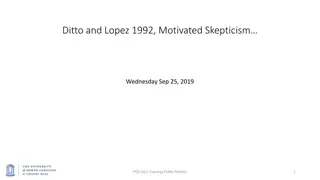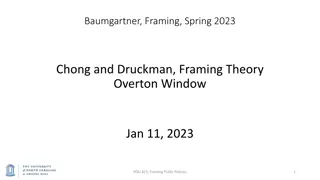Agenda-Setting & Framing in News Content Analysis
Theory of agenda-setting and framing in news content analysis explores how mass media influence public opinion by shaping what topics are deemed important. Developed by McCombs and Shaw, the theory highlights the media's ability to transfer salience of news items to the public agenda. Initial findings from the 1968 research study on the Presidential Election supported this theory, showing a clear correlation between media coverage and public agenda. Agenda setting effects are evident in how news priorities become societal priorities, influencing political and social discourse.
Download Presentation

Please find below an Image/Link to download the presentation.
The content on the website is provided AS IS for your information and personal use only. It may not be sold, licensed, or shared on other websites without obtaining consent from the author. Download presentation by click this link. If you encounter any issues during the download, it is possible that the publisher has removed the file from their server.
E N D
Presentation Transcript
AGENDA-SETTING & FRAMING IN NEWS N OT E S O N N E W S C O N T E N T A N A LYS I S F O R C A S 2 0 4 Z AC K F U R N E S S
AGENDA SETTING RESEARCH ON NEWS
OVERVIEW Theory developed by Maxwell McCombs and Donald Shaw in the late 1960s: Mass media have the ability to transfer the salience of items on their news agendas to the public agenda. As they put it: We judge as important what the media judge as important. Political scientist Bernard Cohen similarly observed: The press may not be successful much of the time in telling people what to think, but it is stunningly successful in telling them what to think about.
ORIGINS: PUBLIC OPINION The idea of Agenda Setting began in 1922 with Walter Lippmann s Public Opinion. In it, he stated that our perception of reality was skewed. The media s portrayal of current events was only that of the media s; viewers do not experience these events first hand. Therefore their own opinions originate more from the opinions of the news source.
INITIAL FINDINGS In 1968 Maxwell McCombs and Donald Shaw conducted a research study to test the effects of media on the publics opinions, using the 1968 Presidential Election To determine public s agenda they asked voters to identify what they considered to be the top issues in the 1968 campaign between Nixon and Humphrey They asked participants what they were most concerned about. Main topics included: foreign policy, law and order, fiscal policy, public welfare, and civil rights. After finding these main topics they researched local Chapel Hill, NC media to see what their priority issues during the campaign were. They compared aggregate data from voters with media content and found that the issues and the ranking of the issues was nearly identical on both lists. The case study s findings clearly supported the Agenda Setting theory: important topics in the news become important to the public, because it is featured by news media. Complimentary research has been done consistently for decades, often corroborating the initial findings, though with some important nuances
WHO SETS THE MEDIA AGENDA? The pattern of news coverage that defines the media s agenda results from 3 key elements: 1. exchanges with sources that provide information for news stories 2. 2. the daily interactions among news organizations themselves 3. 3. journalism s norms and traditions
AGENDA SETTING EFFECTS Stories that are deemed newsworthy become popular as public opinion. Media s priorities often become the priorities of the public and policy makers (Salwen & Stacks,p.90) Influencing the importance of certain political and social issues through the media is considered Agenda Setting. Three distinct consequences of agenda setting effects: 1. Forming opinions 2. Priming opinions through an emphasis on particular issues 3. Shaping an opinion through an emphasis on particular attributes
AGENDA SETTING VS. FRAMING AGENDA SETTING: News media have a large influence on audiences in terms of which stories are considered newsworthy and how much prominence and space are given to them. FRAMING: The basis of framing theory is that the media focuses attention on certain events and then places them within a field of meaning.
THE CONSTRUCTION OF FRAMES IN NEWS JOURNALISM
DEFINING FRAMING News is a window of the world. Through its frame, American learn of themselves and others, of their institutions, leaders, and life styles, and those of other nations and their peoples The view through a window depends upon whether the window is large or small, has many panes or few, whether the glass is opaque or clear, whether the window faces a street or a backyard. - Gaye Tuchman, Making News, 1980 What makes the world beyond direct experience look natural is a media frame [ ] Frames are principles of selection, emphasis, and presentation composed of little tacit theories about what exists, what happens and what matters Thus for organizational reasons alone, frames are unavoidable, and journalism is organized to regulate their production -Todd Gitlin, The Whole World is Watching (1980)
DEFINING FRAMING (CONT) Frames are not the same as topics Frames need to be studies as patterns not single instances within press coverage. Robert Entman defines framing as having two major components: selection and salience: To frame is to select some aspects of a perceived reality and make them more salient in a communicating text, in such a way as to promote a particular problem definition, causal interpretation, moral evaluation, and/or treatment recommendation for the item described.
JOURNALISTIC TOOLS IN FRAMING THE NEWS Choosing the news angle Selecting the sources (and avoiding others) Formulating the headline, the lead of a news story and selecting the visual image Culture bound narratives: formulating a new episode in a longer and well known story.
FRAMING EARLY STUDENT PROTESTS OF VIETNAM (1965) Todd Gitlin, The Whole World is Watching (1980): Trivialization (of age, dress, language, style, goals) Polarization (emphasizing counterdemonstrations) Emphasis on internal dissention Marginalization (deviant or unrepresentative) Disparagement by numbers (under-counting) Reliance on statements by government officials
FRAMING DEVICES IN COVERAGE OF VIETNAM PROTESTS Trivialization (of age, dress, language, style, goals) Polarization (emphasizing counterdemonstrations) Emphasis on internal dissention Marginalization (deviant or unrepresentative) Disparagement by numbers (under-counting) Reliance on statements by government officials
FRAMING THE WTO A few Starbucks windows smashed by a hundred anarchists where all the shallower news reports needed to see to decide what s the story , even if tens or hundreds of thousands of demonstrators were marching by playfully, in peace (Todd Gitlin on Seattle WTO protests, 1999)
NEW EXAMPLE: FERGUSON The police violence frame: Emphasizes the centrality of Michael Brown s murder as the key issue and focal point Emphasizes the impunity of the Ferguson Police Department Puts this specific incident in a larger context of police repression in Ferguson Puts this specific incident in a larger context of both police violence and police militarization on a national scale
NEW EXAMPLE: FERGUSON The peaceful protesters frame: Emphasizes the righteousness and necessity of peoples response to murder The rioters/looters frame: Emphasizes the criminality of protest, despite the circumstances or the specifics of the incident Links this specific incident to other acts of civil unrest and competing philosophies of direct action
NEW EXAMPLE: FERGUSON The criminality thug frame: Relies on racist dog whistles utilized by public figures and politicians since the 1950s, as well as gross news characterizations of black criminality that extend back into the late 1800s Implies that police actions are/were justified, if not provoked Implies that all black men, especially youth, are potential criminals (the same treatment applied to Treyvon Martin coverage). Re-frames the issue as one of law breaking as opposed to racism, regardless of context or circumstance Subsequently, it relies on false notion of reverse racism
LITERATURE Carver, R, R. Waldahl & J. Breivik(2008): Frame that gene , EMBO reports. De Vreese, Claes (2003): Framing Europ . Television News and European Integration, Amsterdam: Aksant Entman, R. (1993): Framing. Toward Clarification of a Fractured Paradigm , Journal of Communication 43 (4): 51-58 Entman, R. (2004): Projections of Power, Chigcago, University of Chigago Press Gitlin, T. (1980): The Whole World is Watching.. (Berkely..: Universityof California Press) Goffman, E. (1974): Frame Analysis, Cambridge: Harvard University Press Ihlen, & S. Allern (2008): This is the Issue: Framing Contests and Media Coverage , in Str mbek, rsten & Aalberg (eds.): Communicating Politics, Gothenburg: Nordicom. Iyengar, S.: (1994): Is anyone responsible. How television frames political issues, Chcago: University of Chicago Press Norris P., M. Kern & M. Just (2003): Framing Terrorism, New York/London: Routledge Reese, S.D., Gandy O.H. & Grant, A.E (eds.) (2001): Framing Public Life: Perspectives on Media and Our Understanding of the Social World. Mahwaa, NJ: Lawrence Erlbaum. Tuchman, G. (1978): Making News. A Study of the Construction of Reality, New York: Free Press Van Gorp, B (2007): The Constructionist Approach to framing: Bringing the Culture back , Journal of communication, 57 (1): 60-78























